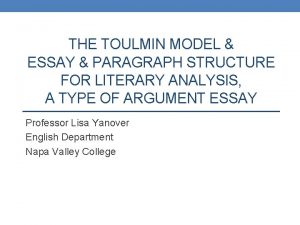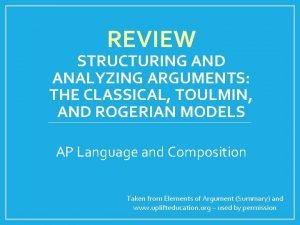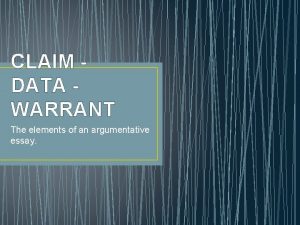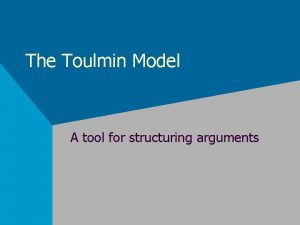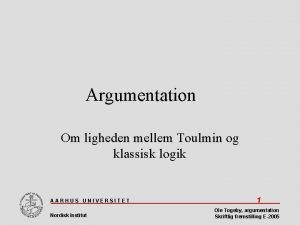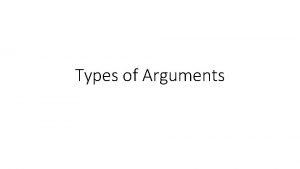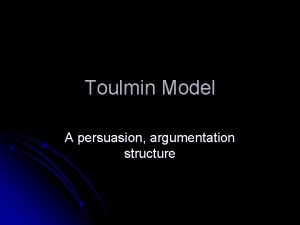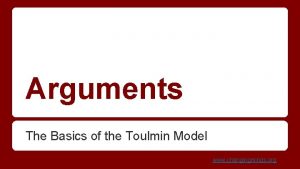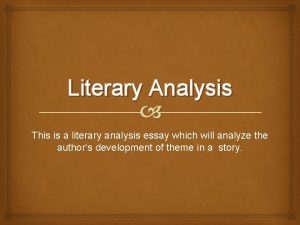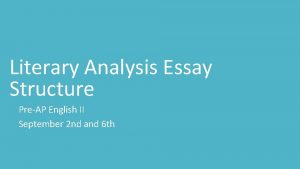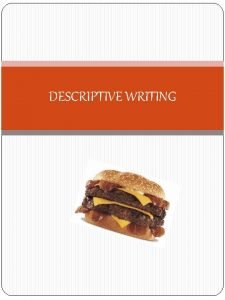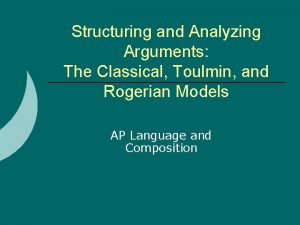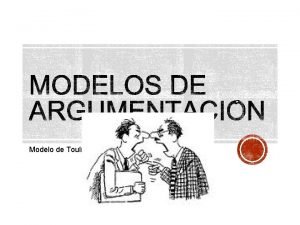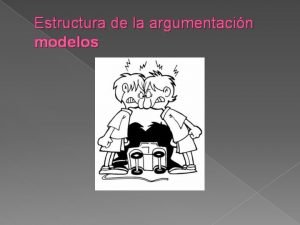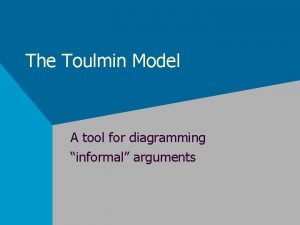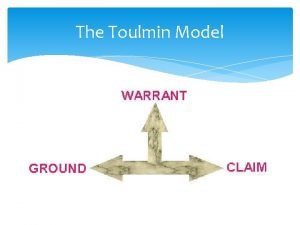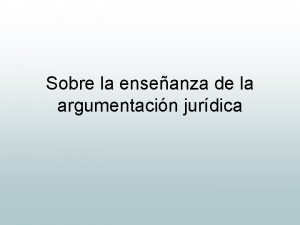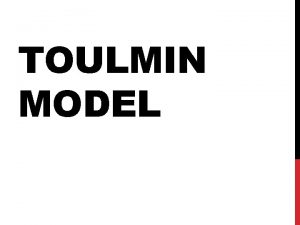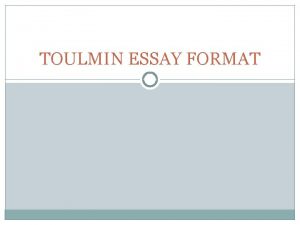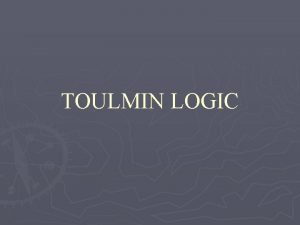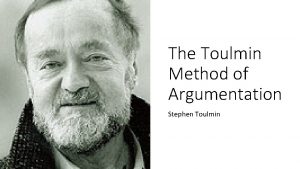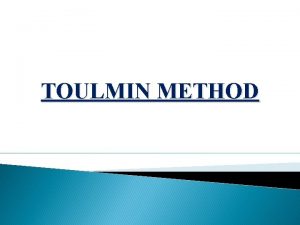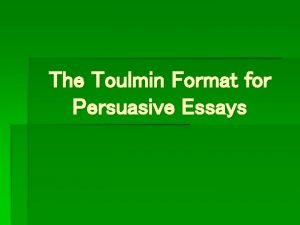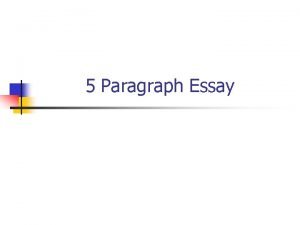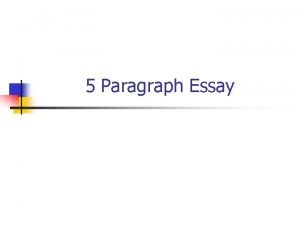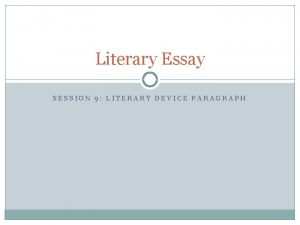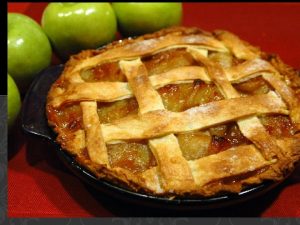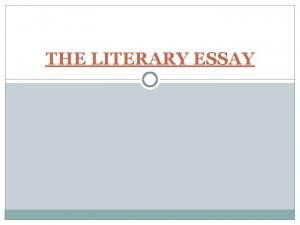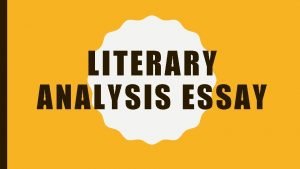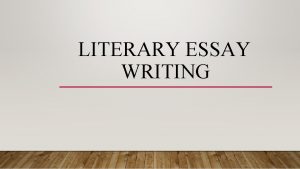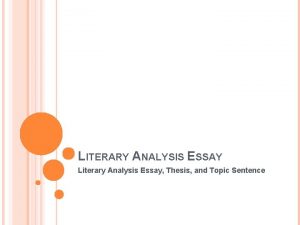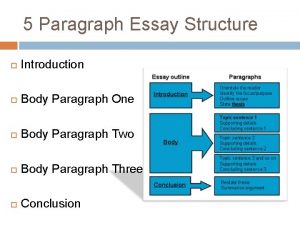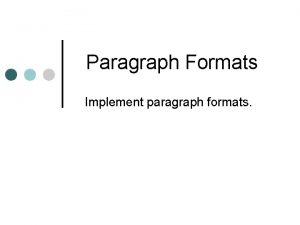THE TOULMIN MODEL ESSAY PARAGRAPH STRUCTURE FOR LITERARY
























- Slides: 24

THE TOULMIN MODEL & ESSAY & PARAGRAPH STRUCTURE FOR LITERARY ANALYSIS, A TYPE OF ARGUMENT ESSAY Professor Lisa Yanover English Department Napa Valley College

PART 1: The Toulmin Model of Argumentation Glossary

The Toulmin Model Complete Glossary • Claim: the main argument or thesis (In literary analysis, your claim presents the text’s claim, and your essay seeks to prove the text makes this argument by showing how it does and explaining why it does. ) • Grounds: the reasons and evidence that support your main argument • Reasons: the supporting arguments (In literary analysis, like the claim, your reason presents an argument the text makes, and the rest of the paragraph seeks to prove the text makes this argument. • Evidence: the general and specific examples and specific details, including quotations, from the text that help show the reason as well as your interpretation and analysis of those examples and details explaining how they mean/prove what the reason says they do. • Warrants: the chain of reasoning (explanation) that connects the grounds to the claim. • Backing: additional evidence and explanation needed to clarify, prove, and develop the claim. • Counterclaim: an opposing argument (reason) a reader might raise to challenge your argument. You anticipate and present this argument and refute it in order to strengthen your argument, not to contradict it. • Rebuttal: reasoning and evidence for how/why your argument is valid despite this objection. (After presenting the counterargument fairly with the minimum amount of evidence necessary to present that argument clearly and accurately, you must explain how/why this objection relates to, supports, or doesn’t negate your claim.

PART 2: The Introduction (Paragraph #1)

PART 2: THE INTRODUCTION – Paragraph #1 • The introduction has 3 steps: • Step 1. Introduce the text and topic. • Step 2. Give context. • Step 3. Present the claim.

PART 2: THE INTRODUCTION – Paragraph #1 Step 1 • Step 1: Introduce the text and its topic or focus. • Include in your first sentence: • the title of the text • the author’s name (if there is one) • the topic or focus of the text (the text and its topic are also the topic or focus of your paper) • For example: • The poem “Hazel Tells La. Verne” by Katharyn Machan presents us with a retelling of the fairy tale “The Princess and the Frog” and, like the original, paints a revealing picture of women’s lives.

PART 2: THE INTRODUCTION – Paragraph #1 Step 2 • Step 2: Narrow the focus and provide context or background. Paint a picture of how the topic is presented in the text. • To help with this step, try answering the questions: • Who or what in the text shows this topic? • Where in the text is it shown? • What in or about the style or structure of the text shows the topic? • In what way is the topic shown? • In this step, suggest but do not give away the claim. Similarly, do not list your reasons (supporting arguments) or evidence.

PART 2: THE INTRODUCTION – Paragraph #1 Step 2 Continued • For example: • This modern retelling, however, focuses not on a princess but a Howard Johnson’s maid. In addition, the poem is told from Hazel’s point of view rather than by a third person omniscient narrator located outside the story at a distance from its events and characters. The fact that Hazel is telling her own story gives it immediacy and authenticity. The spoken diction indicated by the misspelled words and slang used in the poem further enhances its authenticity, suggesting the speaker is comfortable with her audience, expecting her audience to be sympathetic. Indeed, as the title indicates, it is a story told by one woman (Hazel) to another (La. Verne), who shares her language and sensibilities. This new context is feminist and suggest a likely feminist purpose or argument.

PART 2: THE INTRODUCTION – Paragraph #1 Step 3 • Step 3: Present the claim. • The claim in literary analysis is the main argument the text is making. • The claim the text is making is also the claim of your essay. • The claim is the last sentence of your first paragraph. • The claim should be a clear, specific, unified argument (presenting just one idea). • For example: • Indeed, in direct contrast to the message of women’s dependence on men inherent in traditional versions of the fairy tale, this poem argues the self-sufficiency of women.

PART 2: THE INTRODUCTION – Paragraph #1 Sample Introduction Paragraph The poem “Hazel Tells La. Verne” by Katharyn Machan presents us with a retelling of the fairy tale “The Princess and the Frog” and, like the original, paints a revealing picture of women’s lives. This modern retelling, however, focuses not on a princess but a Howard Johnson’s maid. In addition, the poem is told from Hazel’s point of view rather than by a third person omniscient narrator located outside the story at a distance from its events and characters. The fact that Hazel is telling her own story gives it immediacy and authenticity. The spoken diction indicated by the misspelled words and slang used in the poem further enhances its authenticity, suggesting the speaker is comfortable with her audience, expecting her audience to be sympathetic. Indeed, as the title indicates, it is a story told by one woman (Hazel) to another (La. Verne), who shares her language and sensibilities. This new context is feminist and suggests a likely feminist purpose or argument. Indeed, in direct contrast to the message of women’s dependence on men inherent in traditional versions of the fairy tale, this poem argues the self-sufficiency of women.

PART 3: The Body Paragraphs

PART 3: THE BODY PARAGRAPHS– Paragraphs #2, 3, 4, 5, and so on • The Body Paragraphs have 3 steps: • Step 1. Present the reason. • Step 2. Give evidence. • Step 3. Provide warrants and backing.

PART 3: THE BODY PARAGRAPHS– Step 1 • Step 1. Present the reason. • The reason is a supporting argument. • The reason relates to but is different from the claim. • Like the claim, the reason presents an argument the text makes. • Also, like the claim, the reason is clear, specific, and unified (presenting one idea). • The reason focuses the paragraph on the idea (argument) the rest of the paragraph must prove.

PART 3: THE BODY PARAGRAPHS– Step 1 Continued • Step 1. Present the reason. • Each of the following examples is a reason that would be presented at the beginning of a different body paragraph. • For example: • Unlike the vapid young princess in the original story, Hazel is clearly a responsible adult. • Another reason (for another paragraph): • In addition, Hazel is not dependent on protective or instructive parents but entirely independent. • And another reason (for yet another paragraph): • Most notably, unlike the Princess, Hazel is not insulated but worldly. • And another reason (for still another paragraph): • Ultimately, Hazel’s independence and worldliness empower her to act on her own behalf.

PART 3: THE BODY PARAGRAPHS– Step 2 • Step 2. Give evidence. • In literary analysis arguments, all evidence is textual evidence, meaning it comes from and/or is about the text. • Use both general and specific evidence: • General examples relate directly to the Reason • Specific examples and details give specific information about the general examples and relate only indirectly to the Reason. Explanation is needed to point out how specific examples/details relate to and prove the Reason.

PART 3: THE BODY PARAGRAPHS– Step 2 Continued • Types of Textual Evidence: • Facts • Quotations • Description • Summary • Definitions • Explanation • Explication • Contextual information

PART 3: THE BODY PARAGRAPHS– Step 3 • Step 3: Prove & Develop the Claim (Warrants & Backing) • The last sentences of each body paragraph explain (provide warrants of) how and why the reason proves and develops the claim, providing support (backing) for these ideas as needed. • Mainly, these sentences point out: • How the reason relates to the claim • How it means what the claim says or suggests it does • How it adds to or changes our understanding of the meaning of the claim • How it adds to or changes our understanding of the importance of the claim

PART 3: THE BODY PARAGRAPHS– Sample Body Paragraph Unlike the vapid young princess in the original story, Hazel is clearly a responsible adult. She holds down a job as a maid at a hotel. She works alone and unsupervised as the opening lines indicate: “last night / im cleanin out my / howard johnsons ladies room” (1 -3). The work is familiar suggested by her matter-of-fact tone and description; there is nothing complex or hard to understand about cleaning a restroom, nothing worth pausing to describe or explain. It is also clear it is a regular job as she refers to “cleanin out [her] / howard johnsons ladies room” (Machan 2 -3) and later to “hit[ting the frog] with [her] mop” (21). By calling the room and the mop hers, she is claiming ownership, which she wouldn’t do if it were a temporary situation. After all, she is working at a blue collar, likely low-paying job, so she isn’t the owner of the hotel (or its ladies’ room or cleaning tools), but due to longstanding association through work, she has come to think of it as belonging to her: the job and by association the hotel ladies’ room and responsibility for both. Similarly, she assumes the responsibility for both the decision of what to do about the frog as well as its enactment. She doesn’t turn to someone of higher authority to take care of the perceived problem. She simply decides and acts based on her own judgment. By taking responsibility for herself, she is implicitly demonstrating her self-sufficiency; Hazel doesn’t need a frog to transform her into a princess. This frog chose the wrong woman, but because fairy tales are often allegorical, we can understand this modern fairy tale disguised as a poem as speaking about more than just this one woman but about all responsible, adult women, none of whom needs a frog or a man or anyone.

PART 4: The Conclusion

PART 4: THE CONCLUSION • The conclusion has 3 steps: • Step 1: Remind the reader of the Claim. • Step 2: Fully develop the Claim, explaining its larger meaning, purpose, and implications. • Step 3: Provide a strong concluding sentence.

PART 4: THE CONCLUSION– Step 1 • Step 1: Remind the reader of the Claim. • Do not simply cut and paste the same sentence from your first paragraph. • Do use the same term and argument. But build or comment on it. • For example: • Claim: • Indeed, in direct contrast to the message of women’s dependence on men inherent in traditional versions of the fairy tale, this poem argues the self-sufficiency of women. • Claim Reminder: • By insisting on the self-sufficiency of women, this poem not only rewrites this one fairy tale but challenges the whole genre.

PART 4: THE CONCLUSION– Step 2 • Step 2: Fully develop the Claim, explaining its larger meaning, purpose, and implications. • This explanation typically addresses the questions “why” and “so what. ” Some questions you might ask yourself are: • Why is this text/author making this argument? Why does it matter? • What does the author want from the audience in terms of a response? Why? • What is revealed about human nature and/or the society/culture reflected in the text? • What attitude does the text/author have toward that society/culture? • How does the text/author want us to think or feel about this society/culture? Why?

PART 4: THE CONCLUSION– Step 3 • Step 3: Provide a strong concluding sentence. • Avoid ending on weak or vague words, such as “it, that, thing, ” etc. • Do not end with a question unless the essay suggests an answer previously or the question is relevant and provocative and provides closure.

PART 4: THE CONCLUSION– Sample Conclusion Paragraph By insisting on the self-sufficiency of women, this poem not only rewrites this one fairy tale but challenges the whole genre. By having Hazel repulse, attack, and even possibly kill the frog, who comes bearing promises of gifts typically associated with romance and marriage and traditionally provided by men, the poem rejects the male hero, reimagining him as a nuisance and even a potential threat. The poem isn’t arguing that women should respond with violence toward all frogs or men. However, by having Hazel tell the story herself and, in essence, sing her own praises, the poem clearly privileges the woman’s perception and perspective, insisting on her and our ability to tell and direct our own stories for ourselves. While one might ask whether the story that emerges after going through this transformation is even a fairy tale, the response seems to reject this question altogether, insisting instead and in defiance that we do not need fairy tales.
 Toulmin model of argument essay outline
Toulmin model of argument essay outline Pronuntatio
Pronuntatio Claim data warrent
Claim data warrent Toulmin tool
Toulmin tool Toulmin model
Toulmin model Toulmin model
Toulmin model Qualifier toulmin model
Qualifier toulmin model Toulmin model
Toulmin model The great gatsby literary analysis essay
The great gatsby literary analysis essay The critical essay english ii
The critical essay english ii Basic essay and paragraph format
Basic essay and paragraph format Classical argument
Classical argument Cualificador moral
Cualificador moral Modelo de toulmin
Modelo de toulmin Toulmin tool
Toulmin tool Toulmin definition
Toulmin definition Esquema argumentativo de toulmin
Esquema argumentativo de toulmin Structure of expository essay
Structure of expository essay Fspos
Fspos Novell typiska drag
Novell typiska drag Tack för att ni lyssnade bild
Tack för att ni lyssnade bild Vad står k.r.å.k.a.n för
Vad står k.r.å.k.a.n för Varför kallas perioden 1918-1939 för mellankrigstiden
Varför kallas perioden 1918-1939 för mellankrigstiden En lathund för arbete med kontinuitetshantering
En lathund för arbete med kontinuitetshantering Särskild löneskatt för pensionskostnader
Särskild löneskatt för pensionskostnader
